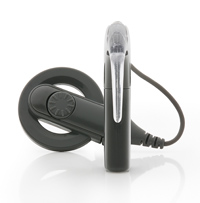Cochlear Implant
What is a cochlear implant?
A cochlear implant is a device that electrically stimulates the auditory nerve of patients with severe to profound hearing loss to provide them with sound information.
How a Cochlear Implant Works

Image from cochlearamericas.com
There are two parts to a cochlear implant: the external and the internal.

- External Sound Processor: This piece sits behind and over the ear with an earhook and looks similar to a traditional behind-the ear-hearing aid. The microphones capture, filter, and process sound and then translate the sound into digital information. The digital information is sent through the external transmitting coil.
- External transmitting coil: The translated sound gets sent through the external transmitting coil which then, via an FM signal, transmits across the skin with a magnet. The internal implant converts the digital information into electrical signals and sends them to tiny electrodes inside the cochlea (inner ear).
- Electrode array: The electrode array receives the electrical signals and stimulates the auditory nerve (hearing nerve). The cochlear implant takes the place of hair cells (cells inside the inner ear that stimulate the auditory nerve) to electrically stimulate the auditory nerve.
- The auditory nerve receives the stimulation and sends the information to the brain, producing a hearing sensation.
How a Cochlear Implant Processes Sound
The goal of all cochlear implants is to electrically encode speech in a manner in which it will be understood in a variety of listening environments. Each cochlear implant manufacturer utilizes different speech-coding strategies. Speech-coding strategies are a set of rules used to convert acoustic signals into electrical stimulation. The objective is to convey high-fidelity electrical representation of the incoming sound, thereby allowing the cochlear implant user to perceive sound in a similar way to a normal hearing listener, even with a severe and/or profound hearing loss.
A cochlear implant considers all three dimensions or acoustic characteristics of sound when utilizing sound-coding strategies: intensity/amplitude (loudness), frequency (spectral/pitch), and temporal (time).
| Acoustic | Perceptual | Electrical |
|---|---|---|
| Frequency | Pitch | Rate and place of stimulation |
| Intensity | Loudness | Amount of electrical stimulation/current |
| Temporal | Time | Rate and pattern of stimulation |
The frequency is conveyed by the site of stimulation in the cochlea. In other words, it pertains to the specific electrodes along the array in the cochlea that are being stimulated. The amplitude is conveyed by the different amounts of stimulation, or current levels, the electrodes receive. Finally, the timing cues are conveyed by the rate, or how quickly the electrodes are being stimulated, and the pattern of the stimulation.
When to see an Audiologist about a Cochlear Implant
- Difficulty communicating in everyday life even with powerful hearing aids
- Avoiding social situations because you do not understand what is being said
- Difficulty understanding when not face-to-face and relying more on lip-reading to understand speech
- Difficulty understanding on the telephone and therefore avoiding answering and making phone calls
- Feelings of isolation from family and friends
- Desire to hear/understand more sound
Cochlear Implant Candidacy
Young children: 12 months to 2 years
- Profound sensorineural hearing loss in both ears
- Lack of progress in development of auditory skill with hearing aids
- High motivation and realistic expectations from family
- Must rule out other medical conditions that may interfere with the cochlear implant procedure
Children: 2 to 17 years
- Severe-to-profound sensorineural hearing loss (nerve deafness) in both ears
- Receive little or no benefit from hearing aids
- Lack of progress in the development of auditory skills
- High motivation and realistic expectations from family
Adults: 18 years and over
- Severe-to-profound sensorineural hearing loss in both ears (>70 dB HL)
- Limited benefit from appropriately fit hearing aids, defined as scoring <50% in the ear to be implanted and <60% in the best-aided listening condition on recorded tests of open- set sentence recognition (Medicare <40% speech recognition)
It does not matter what your age or IQ is, whether you were born deaf or became deaf later in life, if you have other disabilities, or if you have not worn hearing aids, you may still benefit from a cochlear implant. If it was previously determined that you were not a candidate and your hearing difficulties have increased, revisit your audiologist.
Factors that may Affect Adult Performance with a Cochlear Implant
- Length of deafness
- Status of cochlea
- Pre-implant hearing experience
- Number of nerve fibers remaining in the cochlea
- Commitment to the rehabilitation process
- Cognitive factors
- Family support
- Personality and motivation
- Other health issues
General Benefits for Post-Lingually Deafened Adults
- Improved ability to hear soft sounds
- Improved ability to understand speech
- Ability to converse on the telephone
- Improved speech reading ability when combined with auditory information
- May have improved understanding in noise
- Improvement in monitoring the loudness of own voice
- Feeling less isolated and an improvement in daily life
General Benefits for Pre-lingually Deafened Adults
*Considered for those who are auditory/oral
- Improved ability to hear soft sounds
- Improved ability to understand speech
- Improved speech reading ability when combined with auditory information
- Recognition of many environmental sounds
- Improvement in monitoring the loudness of their voice
- Feeling less isolated and more involved in daily life
Important Considerations!
Using a cochlear implant is a whole new way of hearing sound. Therefore, it may take days, weeks, months, or years to be considered a successful user. It is important to speak with your audiologist about proper expectations. These expectations are considered different for every person.
Deciding on which Ear to Receive the Cochlear Implant
There are many variables that need to be taken into consideration when deciding on which ear to implant. The patient, audiologist, and surgeon should determine this as a team. Some of these variables include:
- Cochlear anatomy
- History of hearing loss
- Speech discrimination/understanding per ear, with and without an appropriately fit hearing aid
- Other medical issues
- History of hearing aid usage
- Patient preference
- Handedness
What is the Protocol associated with Receiving a Cochlear Implant?
Clinical protocols vary from clinic to clinic, though there are some general protocols that are shared among the hearing health professional community.
A cochlear implant candidate will need to meet the requirements by undergoing a medical evaluation (including a general health assessment and imaging (e.g. CT, MRI)) and a full audiological evaluation (hearing profile) with and without appropriately fit hearing aids. Additionally, the candidate must meet all FDA requirements to be considered.
The candidate and family/friends of the candidate must undergo extensive counseling on appropriate expectations and be educated on the cochlear implant process, such as the need for frequent follow-ups with the audiologist. Further, they should be educated on what a cochlear implant is, how it looks, and how it works.
Above all, the patient needs to have a desire to be part of the hearing world.


